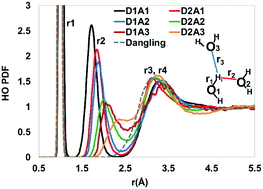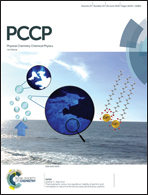Structural aspects of the topological model of the hydrogen bond in water on auto-dissociation via proton transfer†
Abstract
Molecular dynamics (MD) simulations were used to investigate the structure and lifetimes of hydrogen bonds and auto dissociation via proton transfer in bulk water using a reactive and dissociative all-atom potential that has previously been shown to match a variety of water properties and proton transfer. Using the topological model, each molecule's donated and accepted hydrogen bonds were labeled relative to the other hydrogen bonds on neighboring waters, providing a description of the effect of these details on the structure, dynamics and autoionization of water molecules. In agreement with prior data, asymmetric bonding at the sub-100 femtosecond timescale is observed, as well as the existence of linear, bifurcated, and dangling hydrogen bonds. The lifetime of the H-bond, 2.1 ps, is consistent with experimental data, with short time librations on the order of femtoseconds. The angular correlation functions, the presence of a second shell water entering the first shell, and OH vibrational stretch frequencies were all consistent with experiment or ab initio calculations. The simulations show short-lived (femtoseconds) dissociation of a small fraction of water molecules followed by rapid recombination. The role of the other H-bonds to the acceptor and on the donor plays an important part in proton transfer between the molecules in auto dissociation and is consistent with the role of a strong electric field caused by local (first and second shell) waters on initiating dissociation. The number of H-bonds to the donor water is 4.3 per molecule in the simulations, consistent with previous data regarding the number of hydrogen bonds required to generate this strong local electric field that enhances dissociation. The continuous lifetime autocorrelation function of the H-bond for those molecules that experience dissociation is considerably longer than that for all molecules that show no proton transfer.

- This article is part of the themed collection: 2018 PCCP HOT Articles


 Please wait while we load your content...
Please wait while we load your content...
